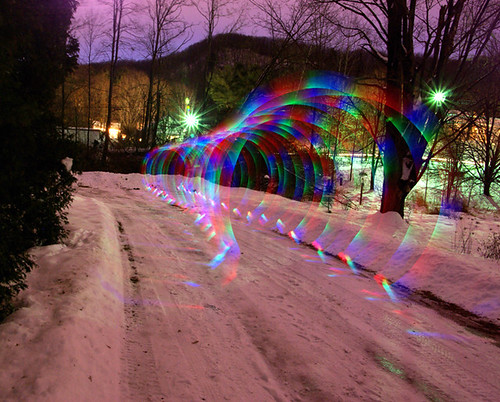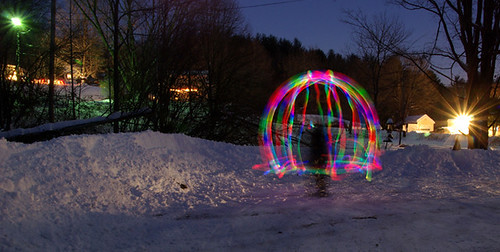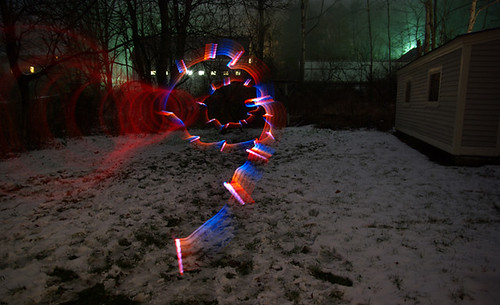 The pictures here are all "Light Drawings." The short version of this is that they are all photographs which use long exposures to capture light in motion. Appearances vary due to a variety of factors. Those factors boil down to a few primary aspects:
The pictures here are all "Light Drawings." The short version of this is that they are all photographs which use long exposures to capture light in motion. Appearances vary due to a variety of factors. Those factors boil down to a few primary aspects:- exposure time, often referred to as shutter speed;
- film speed ("ISO"), which is how much light is needed to render an exposure on the film;
- size of opening in lens (f-stop), which is how big the hole allowing light to reach the film is;
- ambient light in the scene;
- how much light is emitted by the objects being photographed;
Today, I'll talk about some basic photographic techniques and then apply them specifically to light drawings.
But first, one more photo:

Clicking on photos brings you to a larger image with data about exposure length, camera settings, etc.
So let's look at those items I mentioned in turn:
- exposure time:
The longer the exposure time, the more light gets in from the surroundings. This can be good or bad, depending on what you want to do. I've found that longer exposure times can be quite nice, as long as you don't have too much surrounding light (in which case everything can be overexposed. - film speed ("ISO"):
The lower your film speed, the better an image you tend to get. Higher speeds tend to produce pictures with more "noise" to them and the effect is not as nice as you'd like. You, however, don't want to choose a film speed which is too low for your desired effect. If your speed settings are too low, you'll find it difficult to get a proper exposure. You'll need to experiment some to get this right. - F-stop:
this can make a really big difference. Wider openings in the lens (lower-numbered f-stops) can produce much brighter images, but in doing so, they sacrifice depth of field, which is how much of your field of view remains in focus. Wider openings (F 3.5) allow for more light, but less of the photo is in focus. Smaller openings (F 22) provide for much darker pictures but almost the entire shot will remain in crisp focus. This makes for difficult choices sometimes, especially if the light source you're using is not very bright. - how much light is emitted by the objects:
This takes some getting used to. I've got a bunch of different objects I use to generate images and some are much brighter than others. In some cases, I have to move the objects VERY slowly in order to get the same effect I would with others. Below I'll provide some examples.
So let's take a look at this photo:

| f/9.0 | exposure: 3m, 10s | ISO: 100 | 10mm |
I was working with 100 speed film so I know I needed to emit a lot of light from the light objects in question. So I stood a distance from the camera and started spinning this light around (it's a color-changing light). I spun about 20 times, walked a step forward, counted 20 spins, and repeated until I was very close to the lens. This is a good picture, but it's not my favorite-- the F-stop of 9.0 didn't produce as strong a depth of field as I would have liked, so you can see that the background is slightly hazy as is the snow in the foreground. At a tighter f-stop, those would have all been in crisp, clear, focus.
In this one, on the other hand:

| f/13.0 | exposure: 4m, 14s | ISO: 250 | 17mm |
I went with a higher film speed so I could use a tighter f-stop instead. I also had a much longer exposure and didn't use a spinning light object but instead one that I was moving slowly across the shot. It's a crisper and cleaner picture, using the same light source, but in a very different fashion.
It's amazing how many factors can affect the shots you get. The picture above has a lens flare in it, which I didn't expect at all. This picture...

...has a bunch of sparkles throughout. That's because it was snowing at the time and even though the snow didn't come out clear, it reflected light from the laser pen I used to make the shape below. That gave me the inspiration to do more work with that laser pen once it snows again. I may create mirror ball type effects using it, if I can pull them off. One more picture, then some thoughts, and then a few more to close out:

Here are a few things I've learned:
- every camera is different in terms of how it processes artificial light and what light frequencies expose best;
- furthermore, every camera works a little differently at different ISO levels as well;
- every lens is different. My 17-70mm lens creates a different look and feel than my 10-20mm, even if they're both set to 20mm;
- how fast or slow you move an object can make a major difference in how well exposed it is. If you move it very quickly, it may not show up in the shot at all. If you leave it still for too long, it may just appear to be a blob of light. Experiment and learn;
- Different frequencies of light create different effects and different light sources work differently;
- flashing lights create a dramatically different effect from continuous lights;
- the further away a light is from the camera, the less light reaches the camera;
- ambient light has a dramatic effect on the light you manipulate. Doing these pictures shortly after dusk leaves sunlight still visible in the sky. Doing them in an area with street lights produces a different effect than doing them in areas surrounded by darkness;
- nights with full moons are dramatically different from nights with new moons or cloudy nights;
- snow reflects almost all visible light and multiplies it. Same goes for any light-colored, reflective substance;

And remember: most of all, have fun.

A few quick notes: All these pictures were taken using a Pentax K10D camera, but the technique applies to many varieties of camera. They were all taken with Sigma lenses, either a 10-20mm or a 17-70mm.
And I will once again mention that clicking on the pictures brings you to larger versions with more details, as well as the ability to rate the photos, if you feel so inclined.



No comments:
Post a Comment